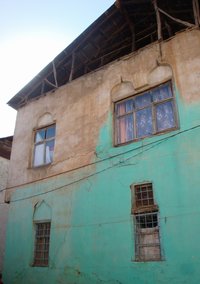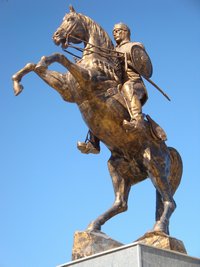Population: 117,000
At first sight Muş, due east of Binğol in the southeast of Turkey, seems to consist of nothing more than a single long street slowly climbing a hill and lined with a predictable array of glitzy modern shops. At the top of the hill, however, modernity falls abruptly away in the Minare Mahallesi (Minaret Neighbourhood), its place taken by a rambling bazaar that feels as if it should be somewhere much further east; somewhere like Pakistan, for example.
Here in a narrow alley men sit selling sacks of fresh tobacco beneath the shade of Algida ice-cream parasols, while in the crowded streets beyond it’s hard to move for shoppers sizing up the bargains on offer in much less flashy traditional shops. In the tiny lokantas men draw lengthy pides (pizzas) out of the oven on even lengthier wooden paddles, while in the local playground skeins of wool hangs up to dry on the swings.
Best time to visit? Probably May when the fields hereabouts redden with flowering tulips.
Backstory
At the end of Muş high street there’s a fine statue of the great Selçuk leader Alp Arslan who led his greatly outnumbered forces to victory over the Byzantine army at nearby Manzikert (Malazgirt) in 1071. In doing so he put an end to a long period in which the Byzantines had struggled with the Abbasids for control of the area.
Even then Muş remained remote from the Selçuks’ main sphere of influence and soon became a local fiefdom. Later Alaeddin Keykubad was able to regain control of the area, whereupon he had the castle strengthened. But in 1243 the Mongols won the battle of Kösedağ and Muş came under the control of the İlkhanid dynasty.
Later it passed to the Karakoyun (Black Sheep) Turks who sought Ottoman help against the fearsome Tamerlane. Shortly after it was the turn of the Akkoyun (White Sheep) Turks to seize control. Then in 1515 Sultan Selim II rode into town to take Muş for the Ottomans under whose control it remained right through until the early 20th century.
Until 1915 the local population was divided almost equally into Kurds and Armenians. Now it is almost entirely Kurdish although a young man who approached me in Minare Mahallesi whispered that his family had been Armenian even if they now called themselves Muslims.
Around town
The Minare Mahallesi has a distinctive style of architecture, albeit one that is fast vanishing. Huge houses, many of them once occupied by Armenians, are made of brick which has been plastered over, with ogival patterns incised around the windows. They look rather like the plaster houses of Siirt, further south, and most are in a similarly poor state of repair.
In amongst the houses there are a handful of fine old mosques with alluring minarets. The Ulu Cami probably dates back to the 14th century although it has been much rebuilt since then, while the elegant Alaeddin Bey Cami is a work of the 18th century despite looking much older. Finally, the Hacı Şeref Cami was built in the 17th century inside the grounds of the pre-existing Arslanı Han (the Lion Inn).
Alongside the Ulu Cami you’ll also see the tomb of the Başları Kesik Şehit Kardeşler (the Martyred Brothers with Chopped-off Heads) to which is attached a strange story. Supposedly two men once arrived in town carrying their heads under their arms. When they died they were buried here together with their heads; the person recounting this tale does so rather sheepishly – “or so they say,” he rounds off.
Near the Aladdin Bey Cami you’ll also see the fine Yıldız Hanı (Star Inn), all that remains of what was once a much bigger complex with shops on the ground floor and space for traveling salesmen upstairs. Even though the Russians did a lot of damage to the building during their occupation in 1916, its facade still bears some fine carvings including a pair of clasped hands which are sometimes said to symbolise fair trade.
At one time Muş also boasted a fine medieval castle. Nothing remains of it now although Kale Parkı (Castle Park) is a pleasant place to come in the evening since it houses a fine restaurant where you can dine outdoors on fine summer evenings.

Note: I have heard rumours that the Minare Mahallesi is slated for redevelopment which doesn’t sound like particularly good news.
Sleeping
It comes as quite a surprise to find Muş well equipped with hotels that while, not exactly boutique or luxurious, are still extremely comfortable. Indeed, you may find yourself tempted to linger for a few days.
Yücesoy Otel Muş. Tel: 0436-212 1625
Zümrüt Otel, Muş. Tel: 0436-212 9605
There are regular buses from Bingöl and Tatvan to Muş.
Day trip destinations
Yüzen Adalar (Floating Islands)


